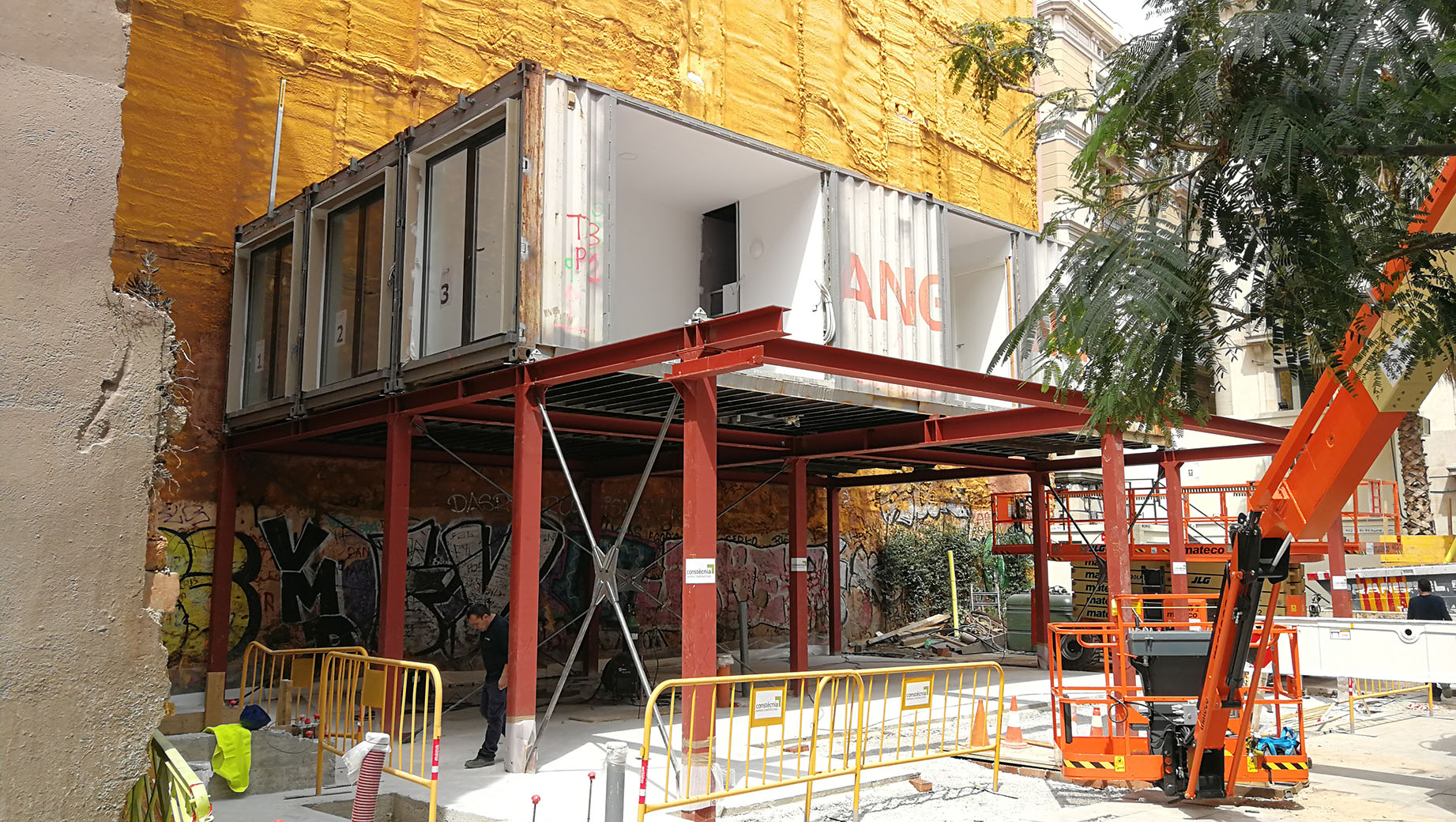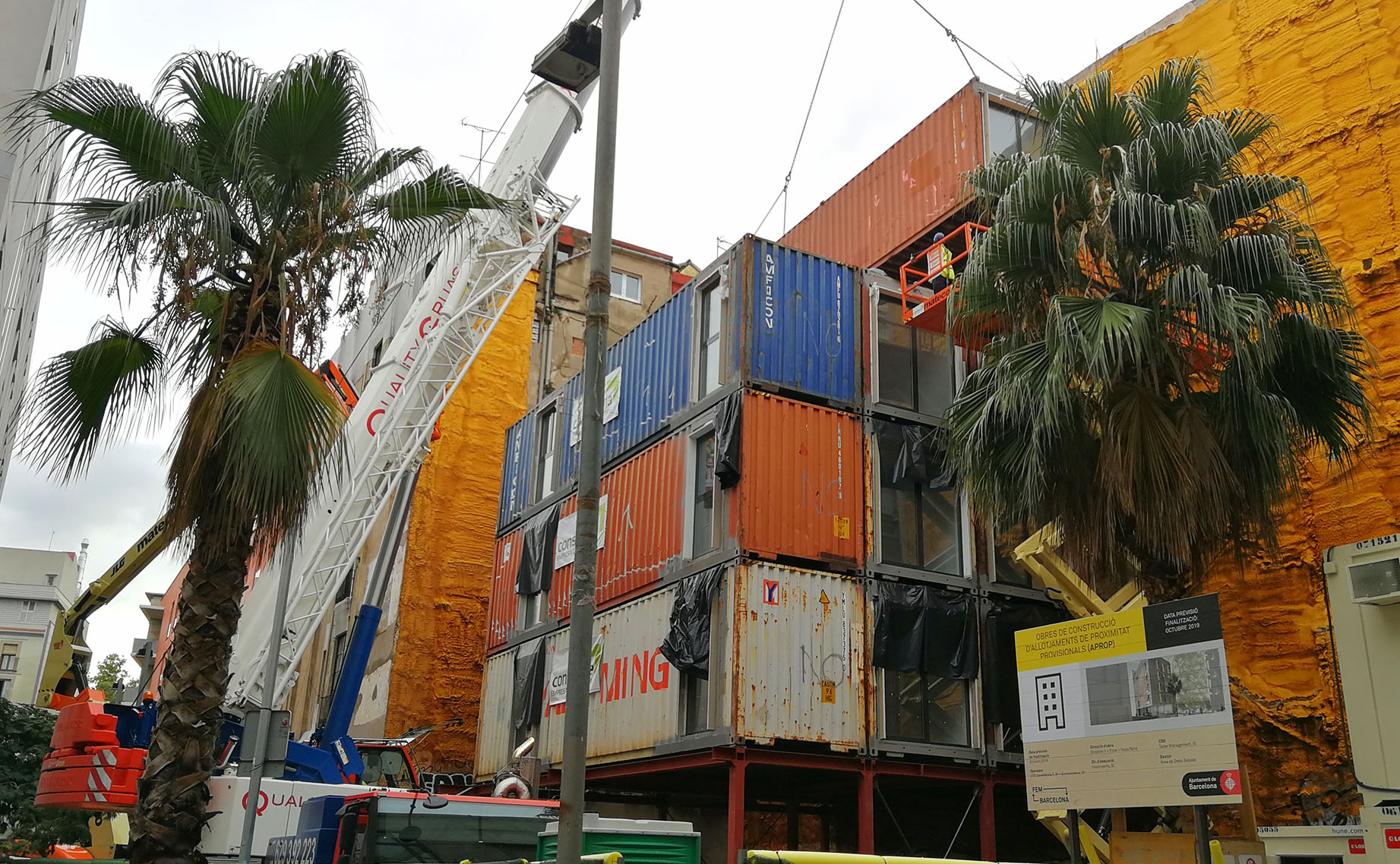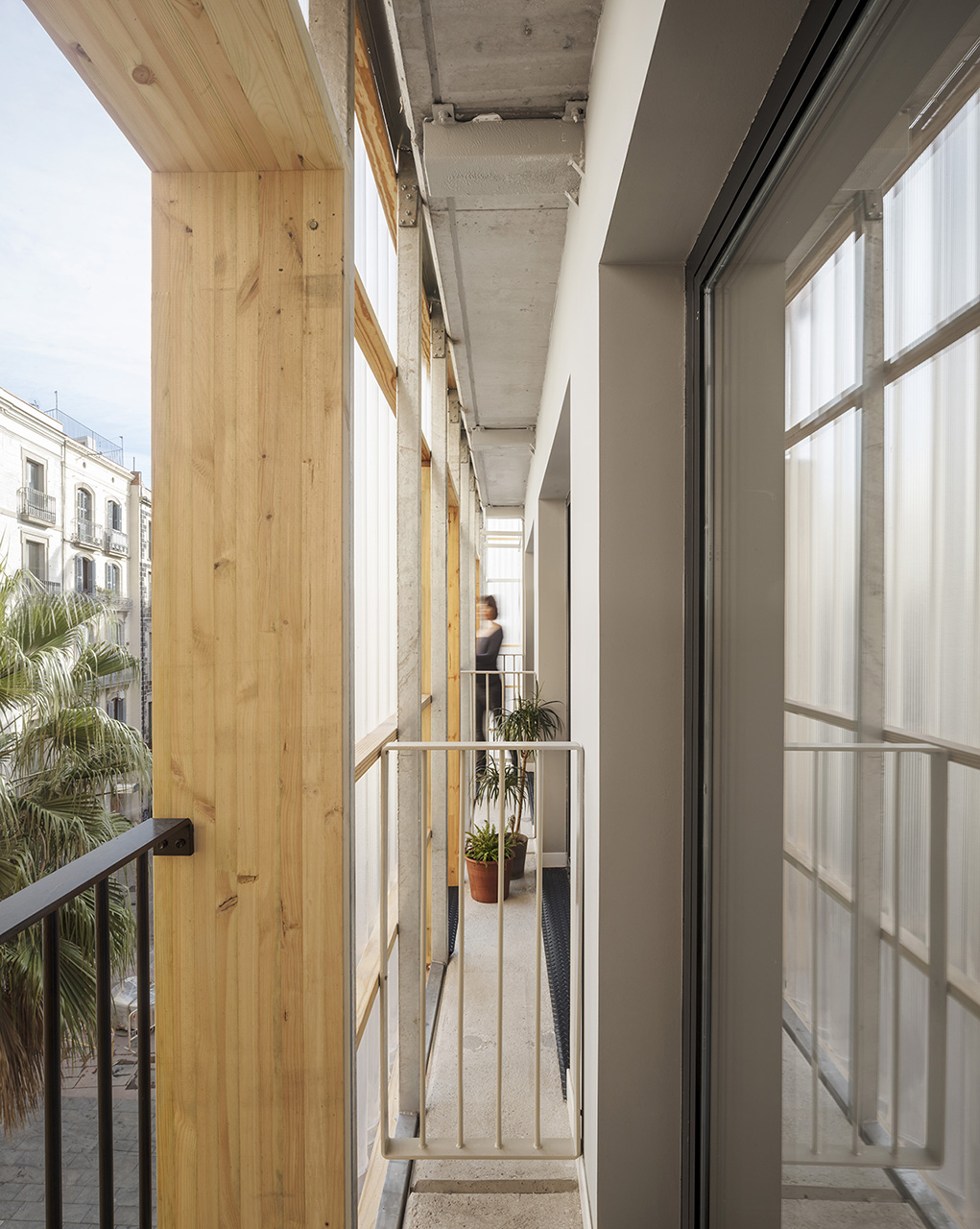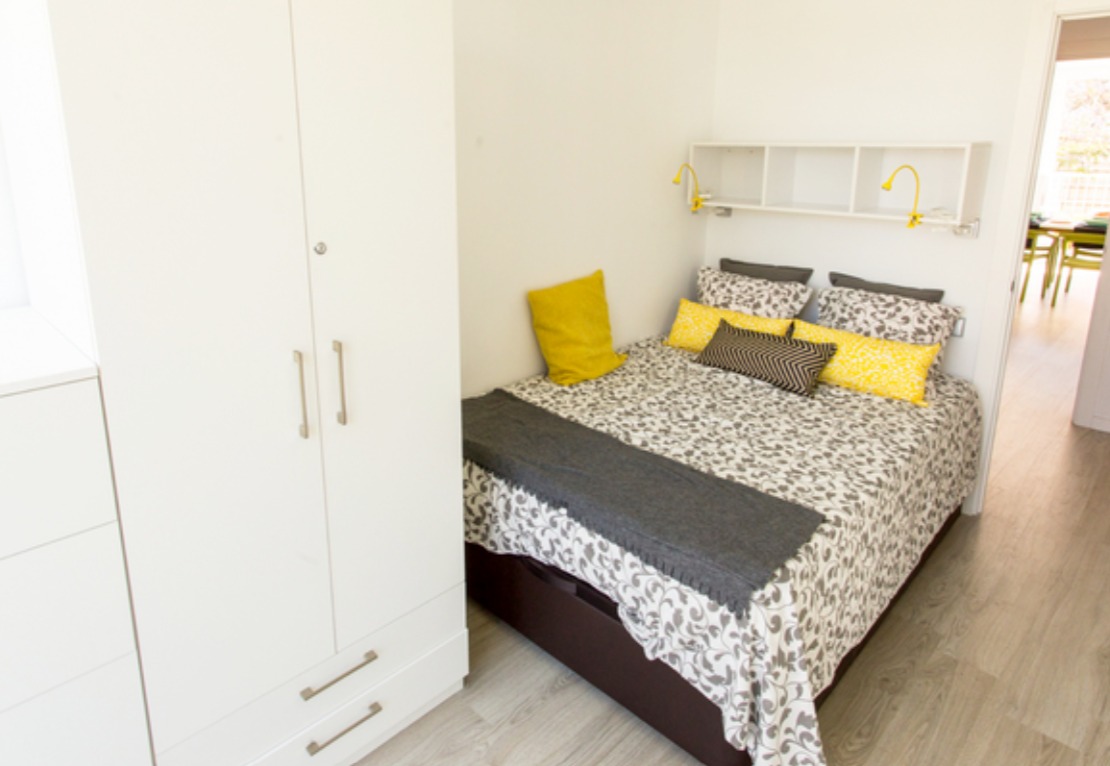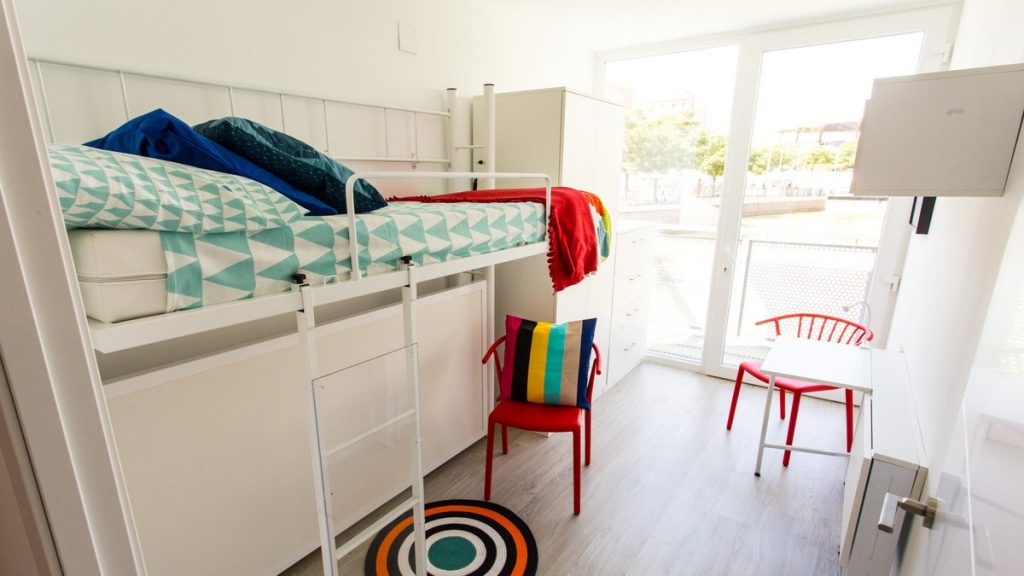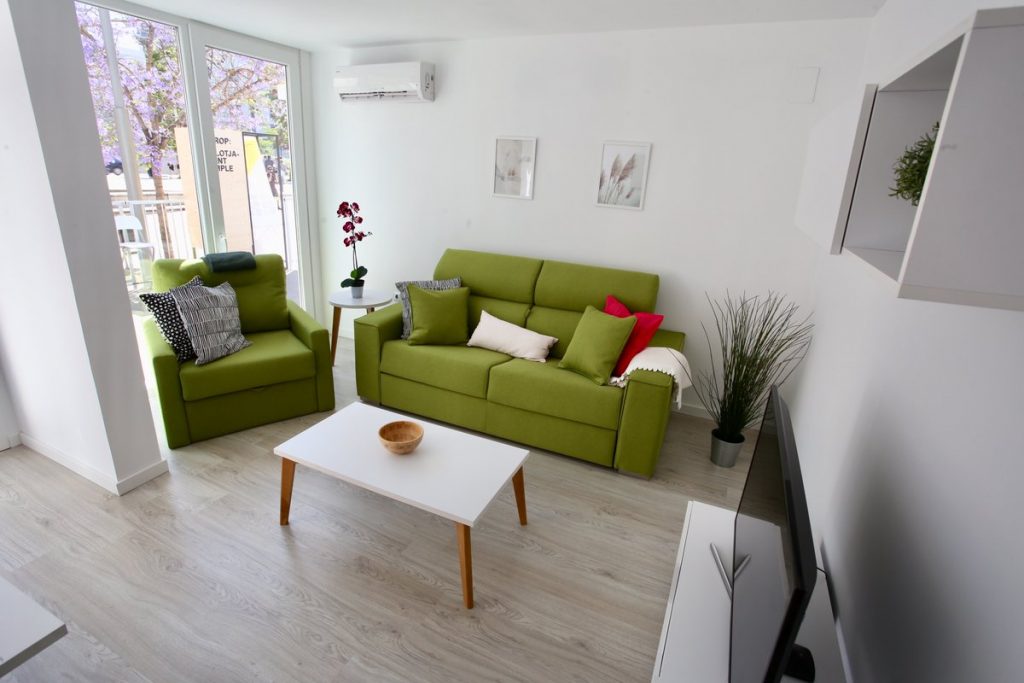APROP | Temporary social housing for people at risk to residential exclusion
Created on 09-06-2022 | Updated on 09-10-2024
The APROP project in Barcelona appropriates used shipping containers, transforming the lightweight steel structures through off-site construction into temporary social housing units. The project won the New European Bauhaus award 2021 within the “Modular, adaptable and mobile living solutions” category, having successfully demonstrated excellence in sustainability, social impact and design.
APROP Ciutat Vella, situated in the city centre, is the first pilot project by the Municipal Housing Institute of Barcelona (IMHAB), which embraces Industrialised Construction to provide more affordable and sustainable housing that is faster to build. The APROP programme provides low-income households facing eviction with temporary social housing as an intermediate solution that can be accessed through an official register, before applying for permanent social housing (Ajuntament de Barcelona, 2019a). The pilot project is a mid-rise apartment block providing 12 dwellings built from 16 upcycled shipping containers, which were pieced together in just four months on site. There are two types of units: four 60m2 two-bedroom homes and eight 30m2 one-bedroom homes, whilst the ground floor houses a healthcare centre. The units are designed to be disassembled with the intention to occupy sites for a maximum period of 5 years, according to the municipality (Ajuntament de Barcelona, n.d.).
From a methodological perspective the APROP programme is a form of “tactical housing” that serves people at risk of gentrification. This is achieved through the agile modules that can be quickly installed within infill sites in various urban contexts, such as vacant land and existing rooftops, close to the applicant’s neighbourhood of origin. Following the success of the Ciutat Vella pilot project, IMHAB has committed to expanding the APROP programme and have already identified several new sites to build additional APROP apartments and this year completed the second project in the Poblenou neighbourhood.
Architect(s)
Straddle3, Eulia Arkitektura, and Yaiza Terré
Location
Barcelona, Spain
Project (year)
2017-2019
Construction (year)
2019
Housing type
multifamily housing
Urban context
City centre
Construction system
Industrialised Construction and prefabricated unit modules
Status
Built
Description
Innovative aspects of the housing design/building
The APROP design and construction system is based on prefabricated modules, providing dignified and energy efficient dwellings for members of society who have difficulties in accessing housing. The homes achieve an AA Energy Rating, which the Barcelona municipality equates to a level of energy consumption four to six times lower than that of a conventional building of the same characteristics (Ajuntament de Barcelona, 2019a). Circularity is integral to the concept of the project, with upcycled shipping containers forming the structure, which would otherwise be considered as waste and sent to landfill. In terms of time and cost savings, owing to the dry and lightweight structure the entire building can be disassembled in four weeks are reassembled elsewhere, significantly reducing on-site construction time.
APROP has been documented as an exemplary project by the municipality and features in the “Innovation in affordable housing Barcelona” and “Barcelona right to housing” reports (Ajuntament de Barcelona, 2018; Hernández Falagán, 2019). The architectural team includes three practices: Straddle3 and Eulia Arkitektura in the design stage, and Yaiza Terré for the delivery stage. Following the announcement of the Bauhaus award, a prize that aims to demonstrate sustainability in alignment with the European Green Deal (European Commission, 2022), Housing Europe declared APROP “an emerging housing model” (Housing Europe, 2021). The project has also been recognised by various other local and international awards (Ajuntament de Barcelona, 2022). Although APROP is built to the same building standards as conventional housing in Barcelona, it received a critical response from a UK newspaper article (The Guardian, 2019), which raised concerns over the danger of lowering standards in the quality of housing if replicated elsewhere. Re-purposing shipping containers to provide housing has become an established industry in many countries but can typically lead to poor thermal and acoustic performance if it is not done well. This was highlighted in the same article by the principal architect David Juárez from Straddle3, who asserted that "building with containers can bring terrible results unless you really make an effort".
Methodology and research project by ATRI
The APROP programme is the result of research carried out by Tactical Accommodations of Inclusive Repopulation (ATRI), an interdisciplinary team supported by the Barcelona municipality that consists of architects, builders, economists, a lawyer, and a social scientist. The group was initiated in response to a lack of social and emergency housing in the Barcelona region. The project framework was formed between the Department of Social Rights, Cooperativa Lacol (the architects responsible for housing cooperative “La Borda”), Bestraten Hormias Arquitectura, and architectural practice Straddle3. ATRI cite the thesis project of architectural scholar Gerardo Wadel on Industrialised Construction and sustainability as further theoretical grounding for the APROP programme (ATRI, n.d.-a; Wadel, 2009). The methodology crosses disciplines to encompass four key areas: urbanism, architecture, economy, and management. This research culminated into the three main characteristics of an ATRI building: reversibility, being lightweight, and minimising execution time.
Construction characteristics, materials and processes
The prefabricated construction method and modular design strategy are characteristic of Industrialised Construction. Although the project is based on off-site construction, this did not take place in a factory setting and traditional manual labour was used (Ajuntament de Barcelona, 2019b). The prefabricated modules were transported through the narrow inner-city streets and placed on site within a steel frame using a large tonnage crane. The lightweight corrugated steel containers used were “last trip” containers that are easily available in the coastal port city of Barcelona, meaning the amount of embodied carbon to transport the containers was more minimal compared to further inland locations. Shipping containers are based on international ISO standards and are designed to universal sizes and can support their own weight whilst being stackable. Therefore, making changes to the structure to provide openings for doors and windows compromises their structural integrity and requires additional structural support. Considering the need to scale up production of the programme and the need to modify the structure, the construction system could potentially be modified in the future to use steel beams and columns formed from recycled material, rather than reusing steel in the form of shipping containers.
The apartments integrate underfloor heating to provide efficient thermal comfort for residents, whilst the double skin façade ensures the homes do not overheat. The skin includes a translucent outer layer made from cellular polycarbonate and timber to increase natural daylight. This also serves to visually adapt the building to its context and allows the shipping containers beneath to be visible. Knauf products were used to create a double plate system in the ceilings and partitions for a structural 60-minute fire rating. The modules, façade and roof incorporate dismountable dry joints for disassembly, recycling, and to enable the easy relocation of parts or whole buildings if necessary.
Energy performance characteristics
The project team claim APROP housing reduces energy consumption by 25% and greenhouse gas emissions by 54% (European Commission, 2021). The double skin façade, layout, and the use of photovoltaics significantly contributed to the achievement of the AA energy certification. These design decisions were tested during the design process using energy simulation models and collaboration with an energy and resource efficiency consultancy (European Commission, 2021). Energy is supplied by an aerothermal heat pump that extracts energy from the ambient air, which is more energy efficient compared to conventional methods. Passive design strategies are also incorporated with exterior openings positioned to produce cross ventilation and maximise sunlight during the winter and shade in the summer months. These techniques significantly reduce heating and cooling demands and further improve the energy efficiency performance.
Financial benefits
The APROP Gothic pilot project cost €940,000. The reuse of shipping containers is reported to have resulted in a 10% material reduction in construction costs compared to traditional methods, in addition to cost savings from a much shorter project programme. These savings are referred to as the Pre-Manufactured Value (PMV) in relation to Industrialised Construction methods, as outlined in the Farmer report (Farmer & Thornton, 2021). The APROP system offers the possibility of further cost savings if the project is replicated through economies of scale; plans are already underway for multiple APROP projects in the city to provide permanent social housing in additional to temporary housing. Work on the second pilot project, a block of 42 dwellings in El Parc i la Llacuna del Poblenou, began in January 2022.
Alignment with project research areas
The interdisciplinary collaboration of stakeholders in the design, community participation, and policy and finance aspects of the programme have been crucial to the successful delivery of the Ciutat Vella pilot project. As the project is ultimately a top-down solution to emergency housing, the project most relates to Design, planning and building and Policy and financing rather than Community participation.
Design, planning and building (Highly related)
The APROP construction system is based on standardised and transportable modules that become more resource efficient through the upcycling of shipping containers, which are also dismountable to enable material reuse and relocation. The design methodology facilitates a city-wide strategy for resource efficiency - a concept known as the urban mine – where the transportable modules are treated as a bank of resources to be managed. High energy efficiency is achieved through passive design strategies and the double-skin façade.
Community participation (Minimally related)
The APROP project is a top-down solution to provide emergency housing, which did not include the direct involvement of future residents. Despite this, the project demonstrated inclusivity with a five-day free exhibition about the project prior to its construction in 2018, which was promoted in collaboration with architecture cooperative Lacol (2018). The public exhibition included a full-scale one-bedroom and two-bedroom unit which were showcased in an outdoor space, complimenting a film screening and talks about the design and aspirations of the project.
Policy and financing (Highly related)
The APROP initiative has been developed through close communication amongst various social agents such as the Federation of Neighbourhood Associations of Barcelona (FAVB), the Technological Institute of Construction of Catalonia (ITeC), and Hàbitat3 Foundation, and has been monitored by the Social Housing Council of Barcelona (CHSB) and the Energy Agency of Barcelona. The APROP programme is currently being expanded by IMHAB and a deal with the European Investment Bank (EIB) is set to provide funding for the construction of eleven additional social housing blocks around the city, providing 489 homes. According to council this project has a budget of €36.2 million, which may be extended up to €65 million (Ajuntament de Barcelona, 2021).
* This diagram is for illustrative purposes only based on the author’s interpretation of the above case study
Alignment with SDGs
The APROP project is directly related to the following Sustainable Development Goals (SDG):
GOAL 3: Good Health and Well-being – A living environment designed to provide optimum comfort.
GOAL 7: Affordable and Clean Energy – Passive design reduces energy consumption alleviating fuel poverty and the use of photovoltaics and aerothermal heat pumps rather than fossil fuels.
GOAL 9: Industry, Innovation and Infrastructure – An innovative and resilient construction system that promotes inclusive and sustainable industrialisation.
GOAL 11: Sustainable Cities and Communities – Making cities more inclusive through anti-gentrification solutions.
GOAL 12: Responsible Consumption and Production – Ensures sustainable consumption and production patterns through circular economy principles.
GOAL 13: Climate Action – Reduction in embodied carbon with the reuse of shipping containers.
GOAL 17: Partnerships to achieve the Goal – Long term partnerships between the council departments and funding partners for planned future projects.
References
Ajuntament de Barcelona. (n.d.). APROP. Retrieved March 14, 2022, from https://ajuntament.barcelona.cat/dretssocials/ca/innovacio-social/aprop
Ajuntament de Barcelona. (2018). Barcelona Right to Housing Plan 2016-2025. https://www.habitatge.barcelona/sites/default/files/en-web_balanc_2018_-_pla_pel_dret_a_lhabitatge_2016-2025-en-gb.pdf
Ajuntament de Barcelona. (2019a). First APROP temporary homes in Ciutat Vella ready to tackle the housing emergency. https://www.barcelona.cat/infobarcelona/en/tema/social-services/first-aprop-temporary-homes-in-ciutat-vella-ready-to-tackle-the-housing-emergency_893737.html
Ajuntament de Barcelona. (2019b). Primer edifici APROP al Gòtic. https://www.youtube.com/watch?v=G36MSb8ilSs
Ajuntament de Barcelona. (2021). European funding to create more housing with affordable rents. https://www.habitatge.barcelona/en/noticia/european-funding-to-create-more-housing-with-affordable-rents_1081791
Ajuntament de Barcelona. (2022). Building gets under way on the second APROP provisional local housing block. https://www.barcelona.cat/infobarcelona/en/tema/housing/building-gets-under-way-on-the-second-aprop-provisional-local-housing-block_1137308.html
ATRI. (n.d.-a). Construction Systems with an Ecological Perspective. Retrieved March 14, 2022, from https://atri.city/en/arquitectura/construction-systems-ecological-perspective
ATRI. (n.d.-b). Construction Systems with an Ecological Perspective. Retrieved March 14, 2022, from https://atri.city/en/arquitectura/construction-systems-ecological-perspective
European Commission. (2021). New European Bauhaus: APROP Summary Information. https://2021.prizes.new-european-bauhaus.eu/index.php/cs/node/269384
European Commission. (2022). Questions and Answers on the 2022 New European Bauhaus Prize. https://ec.europa.eu/commission/presscorner/detail/en/QANDA_22_348
Farmer, M., & Thornton, J. (2021). Pre-Manufactured Value-Cast Technical Manual. www.cast-consultancy.com
Hernández Falagán, D. (2019). Innovation in affordable housing Barcelona 2015 -2018. https://ajuntament.barcelona.cat/barcelonallibres/sites/default/files/publicacions_fitxers/pdf_indexat_innovation_affordable_housing_barcelona_eng.pdf
Housing Europe. (2021). An insight into the New European Bauhaus winner, APROP. https://www.housingeurope.eu/blog-1611/an-insight-into-the-new-european-bauhaus-winner-aprop?mc_cid=eded3c86a2&mc_eid=da5aa9bb0f
Lacol. (2018). EXPOSICIÓ “ALLOTJAMENTS DE PROXIMITAT PROVISIONALS (APROP).” https://www.lacol.coop/actualitat/exposicio-allotjaments-proximitat-provisionals-aprop/
The Guardian. (2019). Sardine tins for the poor?: Barcelona’s shipping container homes. https://www.theguardian.com/cities/2019/sep/06/sardine-tins-for-the-poor-barcelonas-shipping-container-homes
Wadel, G. (2009). La sostenibilidad en la arquitectura industrializada: la construcción modular ligera aplicada a la vivienda [Universitat Politècnica de Catalunya]. https://www.tesisenred.net/handle/10803/6136#page=1
Related vocabulary
Design for Disassembly
Industrialised Construction
Area: Design, planning and building
Created on 18-10-2023
Read more ->Area: Design, planning and building
Created on 09-11-2023
Read more ->Blogposts
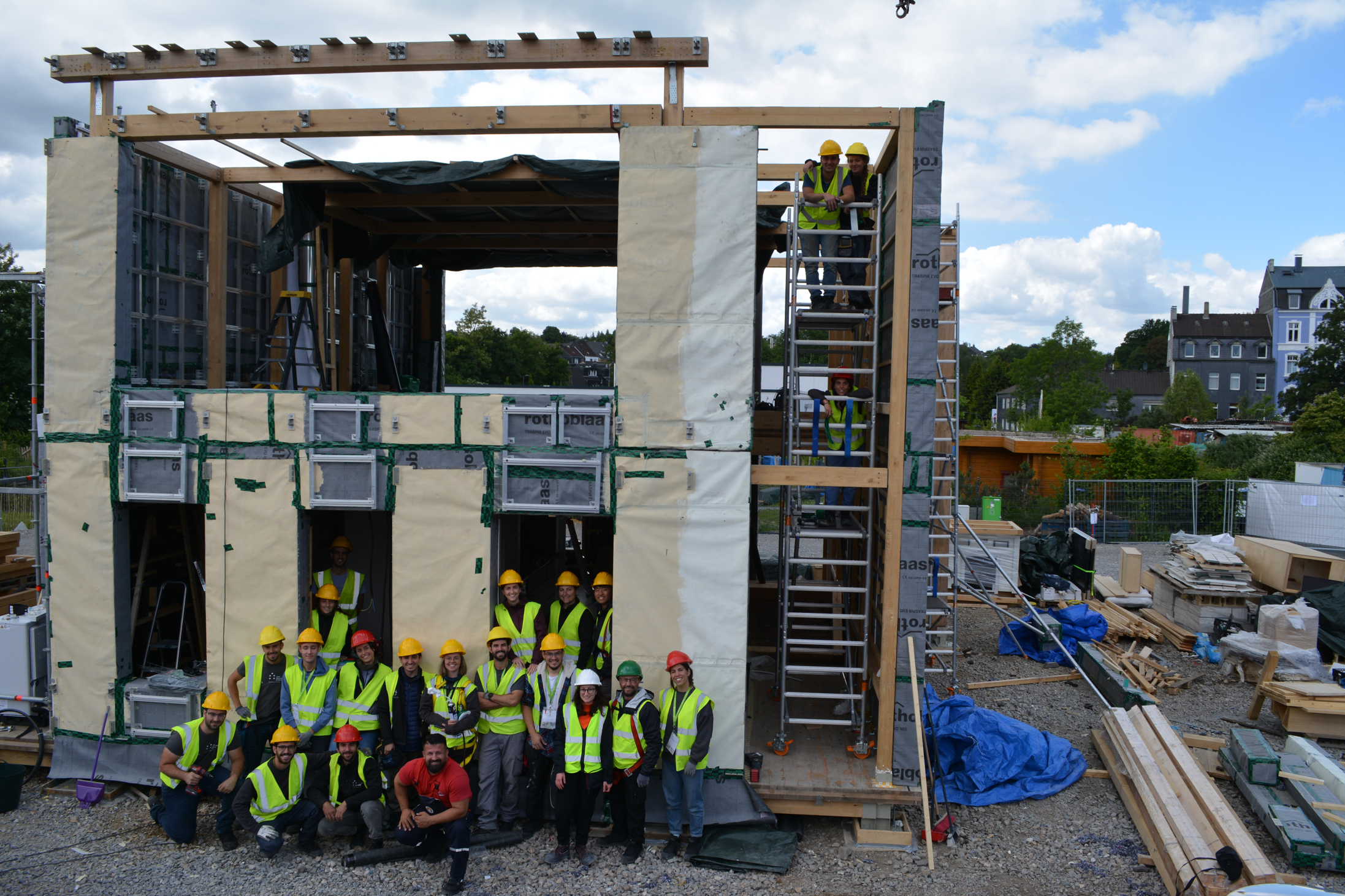
Solar Decathlon Competition and LCA | Secondment with UPV
Posted on 27-10-2022
Secondments
Read more ->


